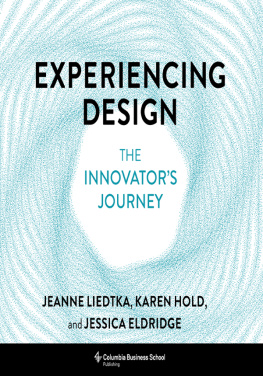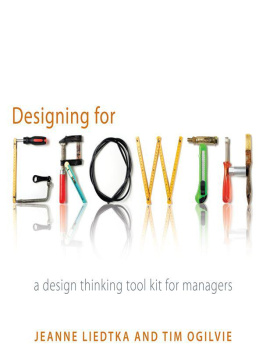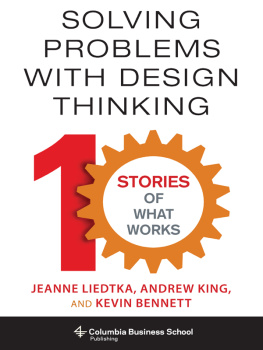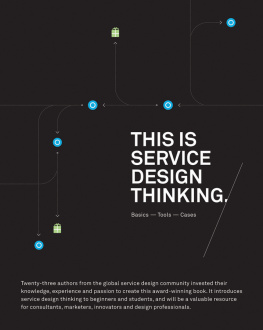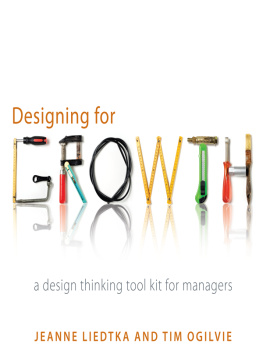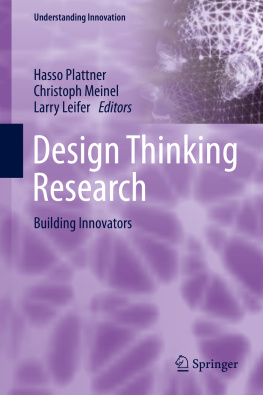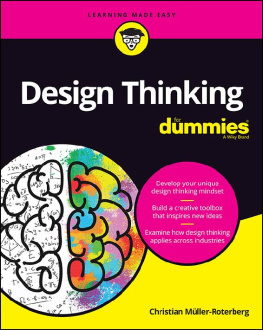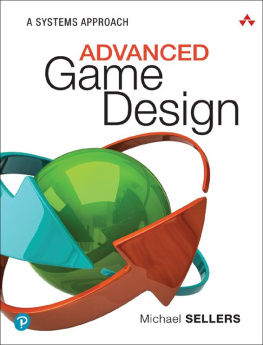Table of Contents
EXPERIENCING DESIGN
EXPERIENCING
DESIGN
THE
INNOVATORS
JOURNEY
JEANNE LIEDTKA, KAREN HOLD,
and JESSICA ELDRIDGE
Columbia University Press
Publishers since 1893
New York Chichester, West Sussex
Copyright 2021 Jeanne Liedtka, Karen Hold, and Jessica Eldridge
All rights reserved
EISBN 978-0-231-55073-4
Library of Congress Cataloging-in-Publication Data
Names: Liedtka, Jeanne, author. | Hold, Karen, author. | Eldridge, Jessica, author.
Title: Experiencing design : the innovators journey / Jeanne Liedtka, Karen Hold,
Jessica Eldridge.
Description: New York : Columbia University Press, 2021. | Includes index.
Identifiers: LCCN 2020058119 (print) | LCCN 2020058120 (ebook) |
ISBN 9780231194266 (hardback) | ISBN 9780231550734 (ebook)
Subjects: LCSH: Technological innovations. | Design.
Classification: LCC HD45 .L476 2021 (print) | LCC HD45 (ebook) |
DDC 658.4/063dc23
LC record available at https://lccn.loc.gov/2020058119
LC ebook record available at https://lccn.loc.gov/2020058120
A Columbia University Press E-book.
CUP would be pleased to hear about your reading experience with this e-book at .
c 1 0 9 8 7 6 5 4 3 2 1
Book design by Leigh Ayers
To all of our students
who inspire us as they work to make the world a better place
CONTENTS
Real isnt how you are made, said the Skin Horse. Its a thing that happens to you. It doesnt happen all at once. You become. It takes a long time. Thats why it doesnt happen often to people who break easily, or have sharp edges, or who have to be carefully kept. Generally, by the time you are Real, most of your hair has been loved off, and your eyes drop out and you get loose in the joints and very shabby. But these things dont matter at all, because once you are Real you cant be ugly, except to people who dont understand.
MARGERY WILLIAMS BIANCO, THE VELVETEEN RABBIT
W e want to start this book with a radical premise: that the transformational power of design thinking (DT, as we lovingly refer to it) lies not in what it encourages us to do, but in who it encourages us to become. Like our childhood friend, the Velveteen Rabbit, DT gives us a chance to become more realto get in touch with our authentic human selves, to restore some of the wonder and creativity that we had as children, but have lost. Being a design thinker doesnt rely on whether you went to design school or not, or have innovation in your job title. The path is there for all of us, if we are willing to make the journey. We become design thinkers by experiencing design.
But like any journey to becoming anything that really matters, you need to prepare to get some hair rubbed off. It is a journey of jubilant highs and frustrating lows. People who break easilywho lack the confidence and courage to be vulnerable and to dream about what is possible; who have sharp edges and think they already know everything they need to know; who have to be carefully kept because they want to be in charge and in controlthey may not make it. We wrote this book for those who want to try. We wrote this book because, after 10 years of dedicated research on the subject, we know that the payoffs to DT done wellto ourselves, our families, our communities and our organizationsare also very real. DT makes us better innovators and better human beings, in a world that desperately needs more of both of those.
But the path there is not nearly as obvious as it might seem.
In daylong hackathons and workshops, DT can seem easy. But our research demonstrates that doing it well is not easy. Practiced at a superficial level, even great design tools like ethnography and prototyping dont go deep enough to create the shifts in mindset and skillset that achieving DTs most significant impacts requires. Novice design thinkers may do DT activities, but do not experience the shifts that reveal new and deeper levels of who they themselves are. It is the becoming, not the doing, that is key to achieving transformational results. Becoming involves changing how we see the world and the rules we use to navigate it. It requires challenging beliefs about ourselves (and others) and letting go of some deep-seated fears. Fully leveraging DTs possibilities requires moving beyond performing the activities it prescribes; it demands that we experience it fully. More so than any other approach to innovation, DT experiences create the space for us to get in touch with our more authentic selves.
You are probably wondering what authenticity has to do with innovation. A lot, it turns out. Many of the barriers to creating powerful new futures are personal. Surethe cultures and processes of organizations can foster them or get in the way. But organizations only change when the people within them change. All change relies on personal transformation, Edward Deming, the central figure in the Quality movement, observed. We need to be someone new to create something new.
AUTHENTICITY
The idea of authenticity has preoccupied philosophers and psychologists for many years. For German philosopher Martin Heidegger, it involves accessing what he called the withheldour higher and better self that lies awaiting emergence. There are preconditions for summoning our withheld. One is voicethe ability to express ourselves in ways consistent with our inner thoughts and feelings. Active engagement is another. The recognition of the power of emotions to our sense of self is a third. Heidegger stresses that the withheld cannot be summonedit can only be invited into a space prepared to welcome it. Finding our authentic self is a developmental processone of continually becoming. Influential developmental psychologists like Erich Fromm, Erik Erickson and Carl Rogers have all stressed the power of authenticity and the enhanced psychological benefits of acting in ways that are true to oneself, with Abraham Maslows hierarchy of needs, and its apex of self-actualization, perhaps the best known. These theories provide useful insights into what the process of becoming entails and what it takes to encourage its exploration. When Heideggers invitation to bring what we normally withhold into a conversation is accepted, the results are transformationalfor us, for our customers, for our organizations and, quite possibly, for our wold.
Maybe weve been looking for innovation in all the wrong places. Or we have just been overlooking some of the right ones. We have looked outside of ourselves to external forcestechnology, customers, other industriesall valid and important, but what have we missed by largely ignoring the creator and focusing on only what they create? How might we tap into the wellspring of innovation within the innovator and unlock the creative potential in each of us? Accomplishing this involves helping them find their higher, better selfthe self who has the courage to ask What if anything were possible?, who doesnt run from any prospect of failure, who can detach their ego from their idea, and who can listen to others through the perspective of what others want to say rather than what they want to hear.

